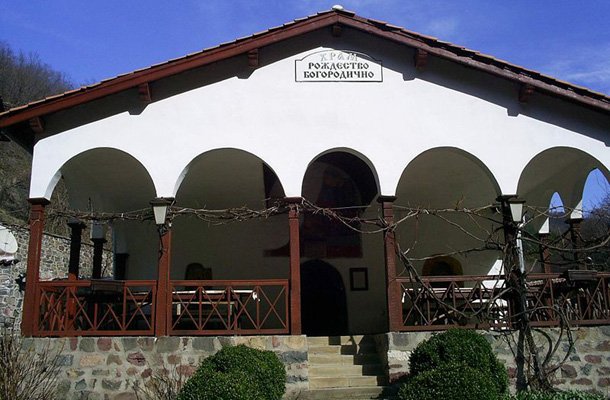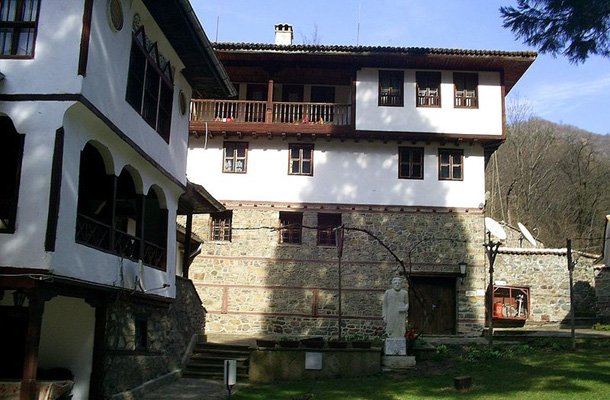The monastery of the Holy Theotokos also known as “The Seven Thrones” is situated 86 km away from Sofia, near the Iskar gorge at the foot of the Stara Planina mountain (the Balkan range). The monastery is located 5 km south of the Eliseina railway station upstream of Gabrovnitza River, a tributary to the Iskar River. This monastery was the most remote and inaccessible in the Sofia Sveta Gora (Holy Mountain) complex.
Many legends exist about its creation. According to one, the monastery was founded by Bulgarian Tsar Peter /927-969/. Another legend says that in the 9th century during the reign of Peter Delian, his brother Knyaz Georgi built the monastery. After the failure of the uprising against Byzantine rule in 1040 led by Peter Delian, Georgi became a monk under the name of Gabriel and became the first abbot here. Hardly these legends could be connected with real historical events. What is certain however is that the monastery was founded during the Second Bulgarian Kingdom near an old castle.

© Photo: wikipedia.org
When the Ottomans arrived, the monastery was severely damaged and for a time it was abandoned by the monks. Later it was again restored. Historical data show that it existed at the beginning of the 16th century. In the 18th century, it was burned and looted. In1815, it was brought back to life by two brothers who were priests - Todor and Marco from Teteven with the help of master Stoyan from Troyan.
The monastery church of the Nativity of Virgin Mary is low, covered with plates with a dome illuminated by eight small windows. The quadrangular dome spaces between the beams of the main cross are surrounded by walls and are divided into seven thrones (or chapels) each of which can be used for carrying out the church services. This kind of spatial design of the temple makes the church unique in Bulgaria. Under the dome is placed a large wooden chandelier called "Horo" consisting of fifteen richly carved parts. This is a unique monument made of skilled wood-carvers of the village of Osenovlag.

© Photo: wikipedia,org
The monastery did not enjoy a long period of tranquillity as at the beginning of the 19th century it was attacked and devastated by the Kurdzhalii gangs of bandits. Its buildings were destroyed and its property went into the hands of a Muslim family. With the help of the Vratsa-born Dimitraki Hadzhitoshev and bishop Dositey in 1824 began a new restoration of the monastery. They redeemed its land, and the monk Paisij from Lovech built residential premises. The Seven Thrones monastery preserves large icons painted by master Stoyan from the Troyan iconographic school. The icons of the highest interest are those of “Virgin Mary with the prophets”, “Christ the Great Bishop of the apostles” and “John the Baptist”. Today, the monastery buildings have been restored reproducing its Renaissance appearance. Above the entrance of the monastery church stands a donor's inscription from which we learn that the dome was painted in 1868. The monastery has a library that contains many old books. It also gave shelter to Sophronius of Vratsa and the Apostle of Freedom Vasil Levski.
On the eve of the feast day of the monastery – the Nativity of Mary on 8 September, many believers suffering from various illnesses come here after sunset carrying lighted torches in their hands. They gathered here on midnight vigil and were quick to leave the temple before sunset, leaving behind illness and misfortune. This custom has been depicted in the poignant tale of the sick boy Monkata in Elin Pelin’s short story "Spasova mogila” (Savior’s mound).

© Photo: wikipedia.org
The rumor says that a Turk, probably attracted by the stories of treasures buried here, plundered and burned the monastery. The robbers killed the old monk, who for years had been ringing the monastery clapper/bell. Yet people continued to see the monk every Sunday morning beating the bell as it reverberated around the nearby crags. Struck by the image of the monk from the legend, in 1899, the patriarch of Bulgarian literature Ivan Vazov wrote the ballad "The bell rings" which explores the influence of this tradition on the rural soul. The famous clapper in the small belfry and the metal gates that once stood outside the church were made of the doors of the old fortress above the monastery, following an order of Bishop Sophronius of Vratsa who found refuge in the monastery in 1799.
The monastery strikes with its extraordinary natural surroundings and the place exudes incredible peace. The monastery complex is composed of an old church, a belfry, a three-storey residential building near the rock beneath the Roman fortress and another two-storey building in the vicinity with monastic cells and a refectory. The Church of the Nativity of Virgin Mary is surrounded by a garden and a vineyard, enveloping the porch. Among the attractions of the monastery is the tomb of Bulgarian writer Zmey Goryanin who, crushed by the communist prisons, wanted find his resting place her.
Today the monastery of the Seven Thrones is active but no monks live here. It is a monument of culture. It is very well maintained and a great place to go hiking. It has accomodation for 50 people, dining and parking facilities and is accessible by car along a narrow paved road from the Eliseina station in the Iskar Gorge.
The author: Valentina Sharlanova is Associate Professor with the Institute for Ethnology and Folklore Studies with Bulgarian Academy of Sciences
English Rossitsa Petcova
Today is Cheesefare Sunday. According to Orthodox tradition, this day is observed on the eve of Great Lent, when Christians seek and give forgiveness to each other . It is also known as Sirni Zagovezni because it marks the last day before Lent, when..
Priest Lyubomir Bratoev is a direct participant in the events of t he founding of the Bulgarian Orthodox Church community in Berlin . He came to the capital of East Germany in the late 1980s as a doctoral student. And, like a typical Orthodox Christian..
After nearly 35 years, the Bulgarian Orthodox Church Community in London has its own church in the central part of the British capital, in close proximity to the Bulgarian Embassy. There, in the prestigious Kensington district, next to Hyde Park and..
Today is Cheesefare Sunday. According to Orthodox tradition, this day is observed on the eve of Great Lent, when Christians seek and give forgiveness to..

+359 2 9336 661
